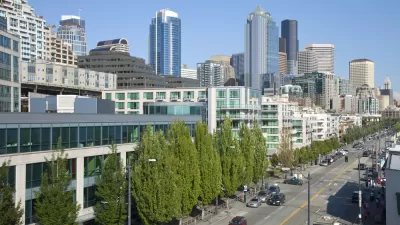As parking reform takes to multi-family housing, the detached single family home has largely escaped discussion. Should it? Seattle (of course) is taking the lead. Also, is all of Minneapolis ready to eliminate parking minimums along transit lines?
Streetsblog's managing editor Brad Aaron addresses two innovative parking reforms proposed in two progressive cities. Seattle considers doing away with the requirement of driveways and garages for single family housing while north Minneapolis debates whether it should be exempted from the proposed ordinance to eliminate parking minimums for multifamily housing developments served by high-frequency bus and rail lines.
As posted here July 8, a Seattle citizens committee has recommended "replacing single-family zoning with a 'lower density residential zone'." "That’s not all," writes Aaron. "The [committee's] draft questions the necessity of a parking spot for every single-family home." The draft is excerpted in a piece by Erica C. Barnett in the Seattle Transit Blog.
Requiring one off-street parking space for every single family home is an artifact of an earlier era and is not a necessary or effective requirement. The space occupied by an off-street garage or parking space could be used instead to accommodate space for housing, including an accessory dwelling unit.
Last month a post here spotlighted a "proposal (that) would eliminate all minimum off-street parking requirements for residential developments very close to high-frequency transit stops." "However, City Council President Barb Johnson wants to exclude neighborhoods in north Minneapolis from the parking reforms," writes Aaron.
The controversy is not unlike those seen elsewhere - some focus on the neighborhood as it is now; others look at what it could be with if restrictions were relaxed.
Resident Jeff Skrenes makes the case for the exclusion in his blog, North by Northside.
- (L)et's talk about those high-frequency bus routes. As a sole factor in contributing to the ordinance, that metric doesn't do north Minneapolis justice. The question that should come up for anyone who has used public transit on the northside is, "Where do those buses GO?"
- North Minneapolis doesn't have the same bike amenities as the rest of the city. We are not a dense, walkable community (yet) that allows residents to meet daily needs on foot, bike, or transit. Until those inequities are addressed, the wholesale removal of parking requirements does a disservice to those who would live in such housing.
in Streets.mn.
- North Minneapolis, particularly Camden, needs multi-family development. Being exempt from the parking ordinance–increasing development costs by hundreds of thousands to millions of dollars–will keep developers from considering Camden.
- Let’s be very clear here: if we don’t create more multi-family housing options with greater density, increasing the population along our transit corridors, we will not get those improved transportation option.
Since our last post on the controversial ordinance by Council Member Lisa Bender, "(t)he measure cleared the city’s planning commission on a narrow 4-3 vote (on June 15, agenda item #7), presaging what may be the largest test yet of the new council’s willingness to challenge long-standing auto-centric policies," writes Eric Roper of the Star Tribune. Arguments to exempt the northside did not prevail.
FULL STORY: More Affordable Housing, Fewer Driveways

Alabama: Trump Terminates Settlements for Black Communities Harmed By Raw Sewage
Trump deemed the landmark civil rights agreement “illegal DEI and environmental justice policy.”

Planetizen Federal Action Tracker
A weekly monitor of how Trump’s orders and actions are impacting planners and planning in America.

The 120 Year Old Tiny Home Villages That Sheltered San Francisco’s Earthquake Refugees
More than a century ago, San Francisco mobilized to house thousands of residents displaced by the 1906 earthquake. Could their strategy offer a model for the present?

In Both Crashes and Crime, Public Transportation is Far Safer than Driving
Contrary to popular assumptions, public transportation has far lower crash and crime rates than automobile travel. For safer communities, improve and encourage transit travel.

Report: Zoning Reforms Should Complement Nashville’s Ambitious Transit Plan
Without reform, restrictive zoning codes will limit the impact of the city’s planned transit expansion and could exclude some of the residents who depend on transit the most.

Judge Orders Release of Frozen IRA, IIJA Funding
The decision is a victory for environmental groups who charged that freezing funds for critical infrastructure and disaster response programs caused “real and irreparable harm” to communities.
Urban Design for Planners 1: Software Tools
This six-course series explores essential urban design concepts using open source software and equips planners with the tools they need to participate fully in the urban design process.
Planning for Universal Design
Learn the tools for implementing Universal Design in planning regulations.
Clanton & Associates, Inc.
Jessamine County Fiscal Court
Institute for Housing and Urban Development Studies (IHS)
City of Grandview
Harvard GSD Executive Education
Toledo-Lucas County Plan Commissions
Salt Lake City
NYU Wagner Graduate School of Public Service





























